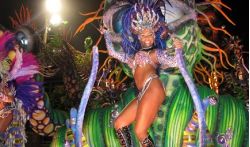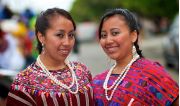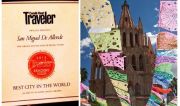The fare of dance in Santiago de Cuba

When the carnival starts in Santiago de Cuba, the whole city turns into one big party! It is an explosion of color, catching drum rhythms and dances. It is also a possibility for Cubans to remember their history and culture, to take a break from everyday work and just have a noisy fun. Carnival in Santiago de Cuba often times to the Cuban national holiday, celebrated on July 26 – the Day of National Rebellion for Cuban independence.
Carnival roots go back to the colonial era, with its religious processions in honor of the saint patron, who gave his name to the city. The residents of a village, founded by Diego Velázquez, walked through the main streets and they went around the cathedral, which to this day is important and where presumably a prominent Spanish conquistador was buried on his own will.
The celebrating of St. James Day (in Spanish – Santiago Apóstol), July 25, was a colorful entertainment for the people, with catchy tunes, awesome masks and colorful costumes. Over time, this event extended to other dates of the month – St. Christina, St. John, St. Anne and St. Joaquin days. Franco-Haitian cultures had an influence on it, bringing traditional costumes, dances and music of their ancestors to the Carnival of Santiago.
During the Carnival, the locals liked to arrange the big feast and drink fruit juice, eat chocolate, cook various soups, drink beer and coffee. Cubans walked on the streets in bright clothes, costumes and masks. All this was accompanied by live music to dance popular dances of that period – contradanzas, danzas, danzones, rigadoons, and walzes. By the end of the 19th century some of the customs of the carnivals (for example, campfires, visits to the caves, torches, horse race) disappeared, and the carnival turned into merely dance festival.
Today, carnivals are a major cultural event of the province of Santiago de Cuba and one of the most important in the whole country.
The second largest city after Havana, Santiago de Cuba is the most exotic city in the country with lots of different ethnic groups living there. For centuries the people from Africa, China, France, Haiti and Spain were coexisting here. The mixture of these cultures is reflected in the richness of Cuban music and dance – conga, rumba and salsa.


The parades of troupes of African descents, in which drumming, conga, bells, Chinese trumpet prevail, are particularly noteworthy. The Chinese trumpet is a bright characteristic of carnival in Santiago. Rhythmic music attracts people and they are dancing, following it, and making pas, which inhabitants of Santiago de Cuba know from birth. The troupes San Pedrito, San Augustin, Paso Franco, Alto Pino, El Guayabito and especially Los Hoyos, the most prominent of all, are very popular here.



The processions please the participants of the fare with bright costumes, brilliance and unity of the choreography. So the troupes La Placita, La Textilera, Heredia and Sueño delight the public, passing along the Vitoriano Garzon Avenue.



On the days of Carnival in Santiago de Cuba the locals and the throngs of tourists who come here at this time from around the world gather in the streets and have fun all night. You will be delighted with the eclectic colorful scenes, local flavors and countless drinks and cocktails. You will not want to miss this party!
Undoubtedly, this festival is the most anticipated by residents of Santiago, many Cubans and foreigners who come to this Caribbean city. They enjoy the music and boundless joy, ruling in the streets, neighborhoods, parks and squares continuously for almost a week.

Guatemala is a small country with a lots of mysteries which have not yet been deciphered. We want to present you some of the facts about this amazing country and we hope that thanks to them, your wish to visit Guatemala will come true.

Condé Nast Traveler, an American magazine, has published Top 5 cities in Mexico by Readers' Choice Awards. The publishers are positioning this annual ranking as the biggest independent survey of consumers in the United States because it is attended by more than 32,663 readers.















